The Glade, barren and savanna macrogroup consists of the following habitats:
Appalachian Shale Barrens
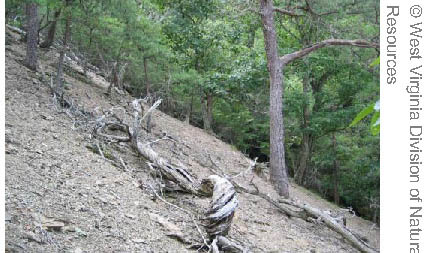

Regional distribution:
MD, PA, VA, WV. 5,169 total acres of habitat, of which 61.5% is conserved.
Description:
A mosaic of woodlands, shrublands, and large open areas of sparse vegetation formed on dry, exposed, steep slopes of unstable shale scree. Dominant trees are primarily stunted red and chestnut oak, scrub oak, pignut hickory, and Virginia pine; on higher-pH substrates the common trees include red- cedar and white ash. Many of these may occur as shrubs, along with prickly pear and various heaths. Shale barren endemics such as shale barren rockcress, shale barren evening primrose and Kate's mountain clover, are diagnostic in the herb layer. This is the distinctive shale barrens of the central Appalachians.
Download the
pdf for this habitat for information about species, crosswalks to state names, and condition of this habitat.
Central Appalachian Alkaline Glade and Woodland
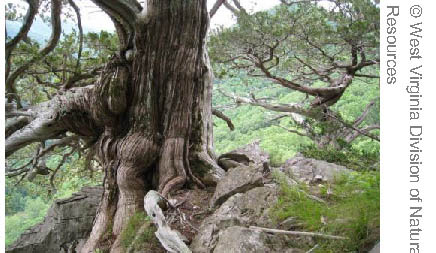

Regional distribution:
CT, MA, MD, ME, NH, NJ, NY, PA, VA, VT, WV. 413,498 total acres of habitat, of which 11.6% is conserved.
Description:
A mosaic of woodlands and open glades on thin soils over limestone, dolostone or similar calcareous rock with its core distribution in the Central Appalachians, but extending well up into New England. In some cases, the woodlands grade into closed-canopy forests. Eastern red-cedar is a common tree, filling in in the absence of fire, and chinquapin oak is indicative of the limestone substrate. In the northern part of its range, northern white cedar may replace red cedar. Other locally occurring trees and shrubs are sugar maple, red and white oak, pignut hickory, eastern redbud, and hackberry. Prairie grasses are often dominant in the herb layer, and forb richness is often high, supporting species such as tall larkspur, american harebell, columbine, and four-leafed milkweed.
Download the
pdf for this habitat for information about species, crosswalks to state names, and condition of this habitat.
Central Appalachian Alkaline Glade and Woodland
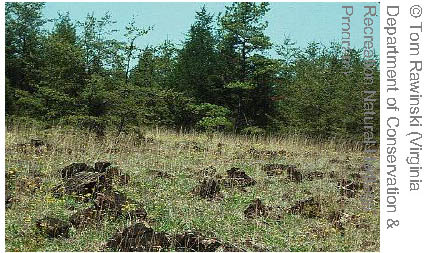

Regional distribution:
DE, MD, PA, VA. 11,954 total acres of habitat, of which 19.7% is conserved.
Description:
An open woodland of distinct vegetation associated with serpentinite, soapstone, dunite, and other ultramafic rock substrates in Maryland, southern Pennsylvania, and Virginia. The open, stunted canopy, often less than 5 meters high, is composed of pitch pine, Virginia pine, white oak, post oak, and/or blackjack oak. Fire suppression probably leads to stronger dominance by pines. Extreme edaphic conditions lead to xerophytic (extremely dry) growing environments, resulting in relatively open structure and a ground cover dominated by prairie grasses and a variety of forbs. Endemics such as serpentine aster and roundleaf fameflower are diagnostic.
Download the
pdf for this habitat for information about species, crosswalks to state names, and condition of this habitat.
Great Lakes Alvar
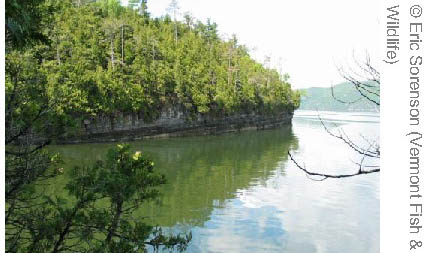

Regional distribution:
NY, VT. 27,656 total acres of habitat, of which 12.3% is conserved.
Description:
A mosaic of grassland, savanna and sparsely vegetated rock barrens occurring on horizontal limestone or dolomite bedrock with a discontinuous thin soil mantle. Eastern red cedar, jack pine, northern white cedar, and a few stunted hardwoods are sometimes present, but never at a canopy cover that exceeds 60%. The dominant herbs are graminoids such as tufted hairgrass and prairie dropseed. Other characteristic plants are sedges, forbs such as white camas, Indian paintbrush, and upland white aster, and distinctive assemblages of mosses, lichens, and small herbs associated with rock outcrops. Alvar communities support several globally rare plant species, and provide habitat for grassland birds whose habitat is declining elsewhere. Most types are globally imperiled.
Download the
pdf for this habitat for information about species, crosswalks to state names, and condition of this habitat.
Southern Piedmont Glad and Barrens
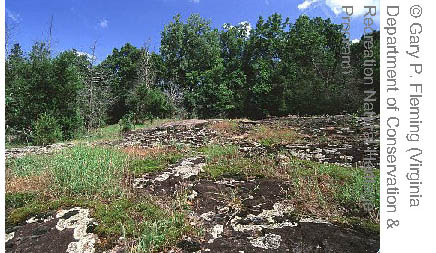

Regional distribution:
VA. 107 total acres of habitat, of which 0.0% is conserved.
Description:
A mosaic of open woodland, shrubland, and herbaceous vegetation occurring on thin soils over igneous or metamorphic bedrock. Vegetation includes a significant woody component, including species such as eastern red cedar and various oaks and pines that are tolerant of dry, shallow soils in the canopy, and white ash, winged elm, and eastern redbud in less acidic areas. Shrubs may be dense, with species determined by soil chemistry. The herb layer is usually fairly dense and dominated by grasses or a mix of grasses and forbs, both in treeless areas and beneath open canopy. This system is structurally intermediate between nonforested rock outcrops and forests, and may occur as a fine mosaic of different structural characteristics. It extends from Virginia down to Alabama.
Download the
pdf for this habitat for information about species, crosswalks to state names, and condition of this habitat.
Southern Ridge and Valley Calcareous Glade and Woodland
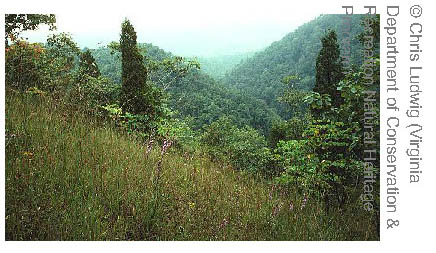

Regional distribution:
VA, WV. 9,418 total acres of habitat, of which 9.8% is conserved.
Description:
A mosaic of open glades and woodlands occurring on shallow, high pH, limestone soils of the Ridge and Valley region from Virginia southward. Chinquapin oak is typical where there is canopy. The flat to rolling terrain and dry soils may have been especially susceptible to periodic fires that helped maintain the prairie-like openings and savanna-like woodlands. Today, much of the system is currently more closed and brushy, suggesting fire suppression.
Download the
pdf for this habitat for information about species, crosswalks to state names, and condition of this habitat.
Southern and Central Appalachian Mafic Glade and Barrens
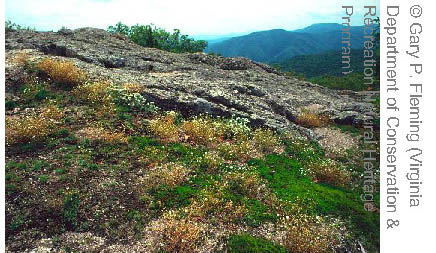

Regional distribution:
MD, VA. 1,456 total acres of habitat, of which 40.2% is conserved.
Description:
A mosaic of open woodland, short-shrub or grassy herbaceous vegetation, and rock outcrops, on shallow soils over predominantly mafic bedrock (igneous rocks rich in iron and magnesium). It generally occurs as a small patch system of a few acres. Vegetation varies according to soil chemistry. Stunted and sparsely distributed tree species include white ash, eastern red cedar, chestnut oak, and dry site hickories. Sumac and ninebark are common species in a shrub layer that may be thick. An herb layer dominated by graminoid species can be fairly dense away from bare rock; some typical forbs are nodding onion, slender knotweed, and woodland sunflower. Bedrock substrates include a variety of igneous and metamorphic rock types such as amphibolite, gabbro, and metabasalt (greenstone).
Download the
pdf for this habitat for information about species, crosswalks to state names, and condition of this habitat.